Extensive reorganization of primary afferent projections into the gustatory brainstem induced by feeding a sodium-restricted diet during development: less is more
- PMID: 17460078
- PMCID: PMC2613514
- DOI: 10.1523/JNEUROSCI.4518-06.2007
Extensive reorganization of primary afferent projections into the gustatory brainstem induced by feeding a sodium-restricted diet during development: less is more
Abstract
Neural development is especially vulnerable to environmental influences during periods of neurogenesis and rapid maturation. In fact, short periods of environmental manipulations confined to embryonic development lead to significant changes in morphology and function. A guiding principal emerging from studies of sensory systems is that experimentally induced effects are most dramatic in higher neural levels (e.g., cortex) and primarily involve postnatal synaptic refinements. In contrast to other sensory systems, the gustatory system is particularly susceptible to the effects of deprivation much earlier and with profound changes evident in the brainstem. Here we show that feeding pregnant rats a custom diet featuring a low-sodium content for 9 d before the tongue appears in the fetus produces extensive restructuring of the gustatory brainstem. Rats born to mothers fed the custom diet from embryonic day 3 (E3) to E12 have terminal field volumes of the greater superficial petrosal, chorda tympani, and glossopharyngeal nerves at adulthood that are expanded as much as 10 times beyond that found in rats fed a standard rat chow. The widespread alterations are not attributable to increased numbers of nerve cells, increased target size, or obvious changes in peripheral taste function. Moreover, we show that the limited period of feeding the custom diet has much larger effects than if rats were fed the diet to postweaning ages. Our results suggest that early periods of altered experience, especially during nucleus of the solitary tract neurogenesis, leads to a restructuring of the gustatory brainstem, which in turn may impact the control of sensory and homeostatic processes.
Figures
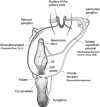
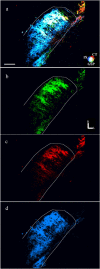
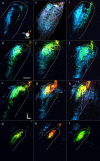

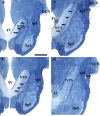


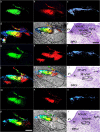
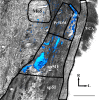

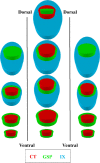
Similar articles
-
Postnatal reorganization of primary afferent terminal fields in the rat gustatory brainstem is determined by prenatal dietary history.J Comp Neurol. 2008 Aug 20;509(6):594-607. doi: 10.1002/cne.21760. J Comp Neurol. 2008. PMID: 18546275 Free PMC article.
-
Chorda tympani nerve terminal field maturation and maintenance is severely altered following changes to gustatory nerve input to the nucleus of the solitary tract.J Neurosci. 2011 May 25;31(21):7591-603. doi: 10.1523/JNEUROSCI.0151-11.2011. J Neurosci. 2011. PMID: 21613473 Free PMC article.
-
Selective Deletion of Sodium Salt Taste during Development Leads to Expanded Terminal Fields of Gustatory Nerves in the Adult Mouse Nucleus of the Solitary Tract.J Neurosci. 2017 Jan 18;37(3):660-672. doi: 10.1523/JNEUROSCI.2913-16.2016. J Neurosci. 2017. PMID: 28100747 Free PMC article.
-
[Progress in the effects of injury and regeneration of gustatory nerves on the taste functions in animals].Sheng Li Xue Bao. 2014 Oct 25;66(5):519-27. Sheng Li Xue Bao. 2014. PMID: 25331997 Review. Chinese.
-
Neural plasticity in the gustatory system.Nutr Rev. 2004 Nov;62(11 Pt 2):S208-17; discussion S224-41. doi: 10.1111/j.1753-4887.2004.tb00101.x. Nutr Rev. 2004. PMID: 15630937 Free PMC article. Review.
Cited by
-
Impact of chorda tympani nerve injury on cell survival, axon maintenance, and morphology of the chorda tympani nerve terminal field in the nucleus of the solitary tract.J Comp Neurol. 2012 Aug 1;520(11):2395-413. doi: 10.1002/cne.23044. J Comp Neurol. 2012. PMID: 22237830 Free PMC article.
-
A survey of oral cavity afferents to the rat nucleus tractus solitarii.J Comp Neurol. 2012 Feb 15;520(3):495-527. doi: 10.1002/cne.22715. J Comp Neurol. 2012. PMID: 21800298 Free PMC article.
-
Factors that regulate embryonic gustatory development.BMC Neurosci. 2007 Sep 18;8 Suppl 3(Suppl 3):S4. doi: 10.1186/1471-2202-8-S3-S4. BMC Neurosci. 2007. PMID: 17903280 Free PMC article. Review.
-
Vegetable and Fruit Acceptance during Infancy: Impact of Ontogeny, Genetics, and Early Experiences.Adv Nutr. 2016 Jan 15;7(1):211S-219S. doi: 10.3945/an.115.008649. Print 2016 Jan. Adv Nutr. 2016. PMID: 26773029 Free PMC article. Review.
-
The effects of dietary protein restriction on chorda tympani nerve taste responses and terminal field organization.Neuroscience. 2008 Nov 19;157(2):329-39. doi: 10.1016/j.neuroscience.2008.09.013. Epub 2008 Sep 13. Neuroscience. 2008. PMID: 18845228 Free PMC article.
References
-
- Altman J, Bayer S. Development of the cranial nerve ganglia and related nuclei in the rat. Adv Anat Embryol Cell Biol. 1982;74:1–90. - PubMed
-
- Barker DJ. Maternal nutrition, fetal nutrition, and disease later in life. Nutrition. 1997;13:807–813. - PubMed
-
- Barker DJ. The malnourished baby and infant. Br Med Bull. 2001;60:69–88. - PubMed
-
- Bradley RM. Boca Raton, FL: CRC/Taylor and Francis Group; 2007. The role of the nucleus of the solitary tract in gustatory processing. - PubMed
-
- Bradley RM, Grabauskas G. Neural circuits for taste. Excitation, inhibition, and synaptic plasticity in the rostral gustatory zone of the nucleus of the solitary tract. Ann NY Acad Sci. 1998;855:467–474. - PubMed
Publication types
MeSH terms
Substances
Grants and funding
LinkOut - more resources
Full Text Sources
Other Literature Sources
Medical
